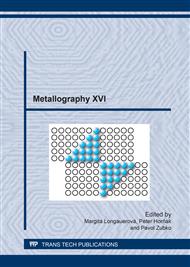p.565
p.569
p.574
p.579
p.589
p.596
p.602
p.608
p.613
Metallographic Investigations of a Late Medieval Pick Found at the Gold Mining Site "Goldzeche-Kleines Fleißtal", Austria
Abstract:
The investigated mining tool, probable a pick, was made of iron and produced in the 15th / 16th century, consequently manufactured in a bloomery. It was used in a gold mine at the Fleißtal located in the Austrian Alps.A metallographic preparation and examination by LOM of the cross section reveals an elongated structure caused by forging. Regions with quite different carbon concentrations, various steel microstructures, slag stringers and oxide inclusions are observed. Extensive microhardness measurement all over the cross section of the pick was performed to get information about heat treatments. Various morphologies of cementite were observed e.g. fine needles, Fe3C at grain boundaries, bainitic and pearlitic Fe3C. But no martensite was found. There are some possibilities: e.g. the hardened surface was removed by corrosion or martensite was transformed (auto-tempered), i.e. cementite was precipitated during long time storage.
Info:
Periodical:
Pages:
596-601
Citation:
Online since:
March 2017
Authors:
Keywords:
Price:
Сopyright:
© 2017 Trans Tech Publications Ltd. All Rights Reserved
Share:
Citation:


